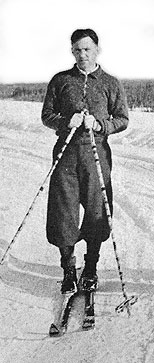Ivar Skarland
by Laurence Irving

Many people who mourn the loss of Ivar Skarland who died 1 January 1965, are grateful
for his friendship and influence during the development of science and society in
Alaska.
Ivar Skarland was born in 1899 and grew up in Norway. After graduating from the School
of Forestry at Steinkjer, Norway, he worked in the forests of Canada and reached Alaska
in 1928. As an undergraduate at the Alaska Agricultural College and School of Mines
(now the University of Alaska) he took part in the Biological Survey investigations
into the food habits of large northern herbivores. While at the school, he met Otto
Geist who induced him to join in excavations at Kukulik, St. Lawrence Island, which
led to important archaeological discoveries and a lifelong friendship and association.
After receiving his bachelor's degree from the University of Alaska he studied anthropology
at Harvard, spending summers in the field in Alaska. He obtained his M.A. in 1942,
and that year became associate professor at the University of Alaska. He was soon,
however, diverted to Army service in the AMutian (sic) Islands. In 1945 he returned
to the University where he remained, except while studying at Harvard for his Ph.D.
which he received in 1949.
Before the War, Skarland was a powerful supporter of the able and venturesome expeditionary
workers who developed the important sites of ancient cultures on St. Lawrence Island
and at Point Hope. After the War these field studies in archaeology continued to progress
during his collaboration with Otto Geist and J. L. Giddings and in the company of
a sequence of distinguished visitors; important archaeological explorations along
the Kobuk River, in the Brooks Range, and on the Arctic coast resulted. Skarland encouraged
and supported scientists in their explorations, and although his name did not appear
often on publications, he exerted a guiding influence through his firm friendship
and wide acquaintance· with the land and people of Alaska.
As host to the scientists who were developing knowledge of Alaska he was at the focus
of a score of investigations that have brought to light localities that are now famous
in archaeology and biology, for example: Cape Denbigh, Anaktuvuk Pass, Onion Portage,
and Kachemak Bay. He prompted the search in the Susitna Valley and along the Denali
Highway that has shown traces of an unexpected ancient population south of the Alaska
Range.
Ivar Skarland was a charter associate and fellow of the Arctic Institute of North
America. Many of its projects in the western arctic resulted from his stimulation
and were sustained by his wise counsel.
Because of his personal qualities and ability to interest men in scholarly exploration
it is not surprising that Skarland was an inspiring teacher. Students liked and trusted
him and a considerable number from his small classes published important anthropological
papers as undergraduates. Those who became professional anthropologists continued
to appreciate Ivar Skarland's encouragement and sincere and constructive criticism.
His knowledge and understanding of people made his advice important in matters of
public welfare and particularly in political and social considerations of Indian and
Eskimo residents as their lands became settled and their ways changed. Looking upon
his active life in Alaska we find that Ivar Skarland steadily exerted a powerful influence
among scientists, students and his fellow citizens. Not only was he the firmest of
friends but his friendship stimulated scholarship, and the progress of the various
races as citizens in a northern society.
UA Sites named after Ivar Skarland
Link
Skarland Hall Dedication by William Cashen
Sources:
Alaska Alumnus. Cashen's Corner. Spring 1971
Cashen, William R. Farthest North College President
Cole, Terrence. The Cornerstone on College Hill.
Jozwiak, Eric. Association Director for Residence Life. University of Alaska Fairbanks
Tremarello, Ann. Director Admissions and Records. University of Alaska-Fairbanks 1987-1988 Catalog
